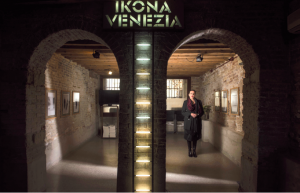EVENTS “Venice Connects Past and Future”
“My name is Živa”. Thanks to the way she introduces herself one can understand many things about her. It is not all about her raspy voice: I feel her strong and vaguely unsettling presence while she gazes at the pictures hung on the walls of her Ikona Gallery. Despite being motionless and silent, I sense her uncommon grit and her craving for wonderful and real things. In order to understand her we have to look back: “I was born in Zagreb in 1945, twenty minutes after my twin brother Ognjen, but I did not cry, so my mother asked «To je živa? Is she alive?». So I became Živa”. These are the first words of a video produced by the University of Nova Gorica in 2014, in which Živa tells her story, beginning from one of her 1976 works, in which the sound of an old camera accompanies the image of a young black-and-white hand caressing a wall. This hand is replaced by Živa Kraus’s hand; she is a painter, art dealer and artist. Her fingers, the skin marked by time, lightly touch the walls of her Venice: “I arrived in Venice chasing my inner voice… After my first solo exhibit, in Zagreb, I was thinking about going to Paris, but in the end something brought me here, to this unique city”.
Her profound love for Venice does not stop her from criticizing the place whose changes she has experienced, a place which “should not be compared to anything, because it is unique and peculiar”. Venice used to be very different but, in spite of those who say that the Ghetto is now empty and lifeless, she thinks that “once here everything was grey and empty. Every kind of present somehow unites past and future. Especially in Venice, because Venice is like a theater that Živa knows very well as she has been living there for 40 years and where she founded her Ikona Gallery in 1979. Its first location was a room near San Moisè bridge; after a little bit of wandering, the gallery was finally moved to Cannareggio, in Campo del Ghetto Novo, in 2003. “Venice is not too big, it is a human scale city, but it makes you keep its rhythm. It makes you walk most of the time; everything I have to do for the gallery or for myself I have to do it walking, and this has allowed me to seize the city. I am part of Venice”.
Živa’s family moved from Moravia to Croatia during the Austro-Hungarian Empire; her parents have greatly contributed to the cultural growth of Zagreb. After having looked for refuge in Italy, so as to escape from the horrors of World War Two, they managed to move to Switzerland. They went back to Zagreb after the war and retrieved the ruins of the synagogue, which the fascist authorities had ordered to destroy in 1941.
Today, Ognjen, her twin-brother that came into the world twenty minutes before her, is head of the local Jewish community, while Živa has been Peggy Guggenhheim’s assistant (she will dedicate an exhibition to her during the next few months), collaborator and curator for the Venice Biennale, as well as curator at the Sebastian Gallery in Dubrovnik.
The Ikona Gallery itself does not only have exhibitions: the Ikona Venezia International School of Photography, in which many workshops with major photographers was created and opened in 1989. Živa herself is a great artist and, as her friend Alberto Moravia had described her, she is a “realist of the invisible, she can deliver the reality of the desiring energy”. Her gallery, one of the first ones dedicated to photography in Italy, represents passion as well as a civic sense, the will of offering to her adopted city something that has to do with the sensibility, attention and expertise that she has acquired working with great photographers over the years. “I think that every city has its own body, and so when one works in a passionate and honest way, he or she opens oneself to the city and establishes a sort of dialogue with a living entity”. Alive, like Živa.
“In a city that is transit point for the world, the Ghetto does not only represent the cell of my gallery, it is also the cell of a mosaic, the cell of a bigger space.”
Živa Kraus, the Croatian artist, lives in Venice, where she founded the Ikona Photo Gallery, in which the greatest photographers of the world have taught and displayed their works since 1979.
According to her, “The Ghetto is an island inside the island, the city inside the city, and in addition it is a complete memory.” A memory that tells us an ancient but still living story.
*This article has been translated by Ilaria Modena, student at the Scuola superiore interpreti e traduttori di Trieste, who is doing her apprenticeship in the newsroom of Pagine Ebraiche.

